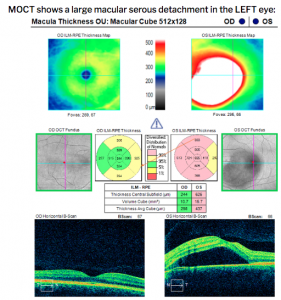Dr. Noskow’s Case Report
Central Serous Chorioretinopathy
39-year-old white, male, presents with “large brown colored blurred spot” in his central vision of his left eye, occurring constantly for the past four days. This patient denies any recent facial/ocular trauma and denies a history of any eye problems.
On initial presentation in the office, best-corrected visual acuity is 20/20 in the right eye and 20/70 in the left eye. Pupils were within normal limits with no afferent pupillary defect. Extraocular muscle motility was within normal limits. Examination of the anterior segment (or front surface of the eyes) was within normal limits.
Upon dilation of the pupils to examine the back part of the eye (otherwise known as the retina & macula) you can clearly see a round, well-delineated, macular serous detachment surrounded by a classic halo light reflex, with loss of the central foveal light reflex. In other words, this means that an area of fluid build-up/irregularity is seen in the macular/foveal region of the retina, the area that is responsible for our central vision or viewing. This condition is known as Central Serous Chorioretinopathy (CSCR).
-
This condition commonly affects men more than women, in their 30-50s
-
Commonly affects people under a lot of stress & people with “type A” personalities
-
Some other risk factors include: steroid medications, sleep apnea/insomnia, and autoimmune disease
Visual field testing shows loss of central vision in the left eye as seen below:


